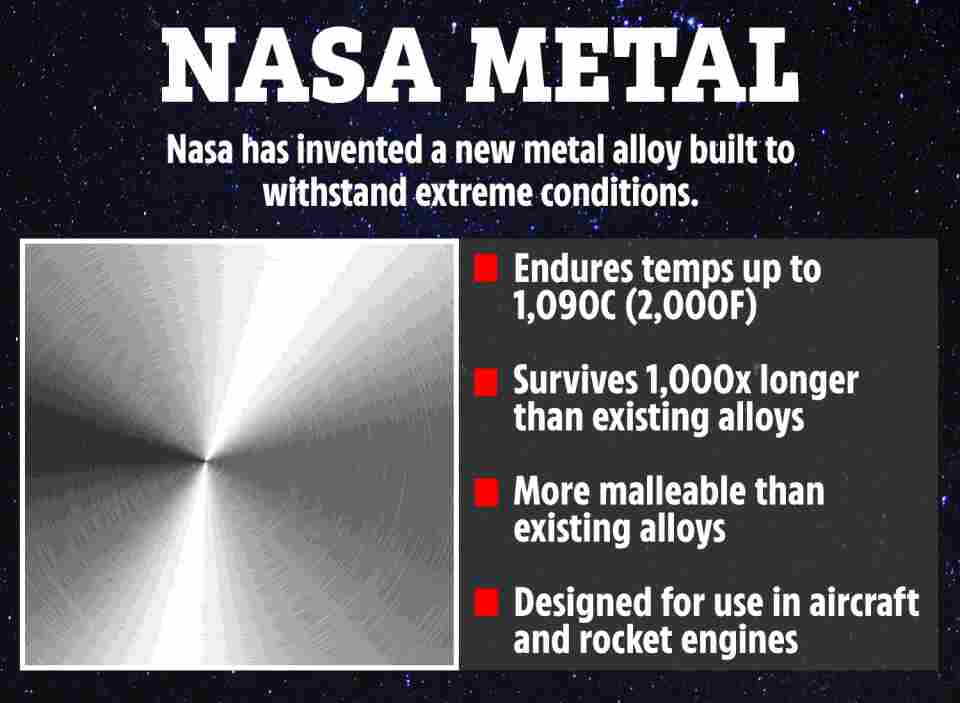Politics
Nasa invents NEW ‘super metal’ that survives 2,000F temperatures for ultralight airplanes of the future

NASA has invented a new super material built to withstand extreme conditions.
The metal alloy was created using a 3D printing process and could revolutionise air and space travel.
The Sun
It can endure temperatures over 2,000F (1,090C) and is more malleable than existing state-of-the-art alloys.
Called GRX-810, the material can also survive more than 1,000 times longer than other alloys, Nasa said in a statement last week.
“These new alloys can be used to build aerospace parts for high-temperature applications, like those inside aircraft and rocket engines,” Nasa said.
GRX-810 is an oxide dispersion strengthened (ODS) alloy, meaning chemical compounds called oxides are embedded across its surface.
Read more about Nasa
ODS alloys can withstand harsher conditions before reaching their breaking point.
That makes them perfect for the brutal environments in and around aircraft and jet engines.
To figure out the arrangement that would make the material as durable as possible, engineers turned to computer models.
They used the models to simulate the thermodynamic performance of the alloy and then 3D-printed it.
Most read in News Tech
They arrived at the optimal design after around 30 simulations in a process of trial and error that is said to improve efficiency.
Nasa said that the design and creation of aerospace materials used to take years but thanks to computer models can now take weeks.
At temperatures of 2,000F, GRX-810 is twice as resistant to fracturing as other state-of-the-art alloys.
It also offers three and a half times the flexibility without cracking when bent and more than 1,000 times the durability under stress.
Nasa says the material opens up new possibilities in aircraft design and could allow for lighter components.
Jet engines built using the material would lose less fuel and aircraft would have lower operating and maintenance costs.
“These alloys have major implications for the future of sustainable flight,” Nasa said.
“For example, when used in a jet engine, the alloy’s higher temperature and increased durability capability translates into reduced fuel burn and lower operating and maintenance costs.
Read More on The Sun
“This alloy also affords engine part designers new flexibilities like lighter materials paired with vast performance improvements.
“Designers can now contemplate tradeoffs they couldn’t consider before, without sacrificing performance.”
A turbine engine combustor 3D printed at Nasa’s Glenn Research Center
Read all the latest Phones & Gadgets newsKeep up-to-date on Apple storiesGet the latest on Facebook, WhatsApp and Instagram
Best Phone and Gadget tips and hacks
Looking for tips and hacks for your phone? Want to find those secret features within social media apps? We have you covered…
How to get your deleted Instagram photos back
How to track someone on Google Maps
How can I increase my Snapchat score?
How can I change my Facebook password?
How can I do a duet on TikTok?
Here’s how to see if your Gmail has been hacked
How can I change my Amazon Alexa voice in seconds?
What is dating app Bumble?
How can I test my broadband internet speed?
Here’s how to find your Sky TV remote in SECONDS
We pay for your stories! Do you have a story for The Sun Online Tech & Science team? Email us at tech@the-sun.co.uk

